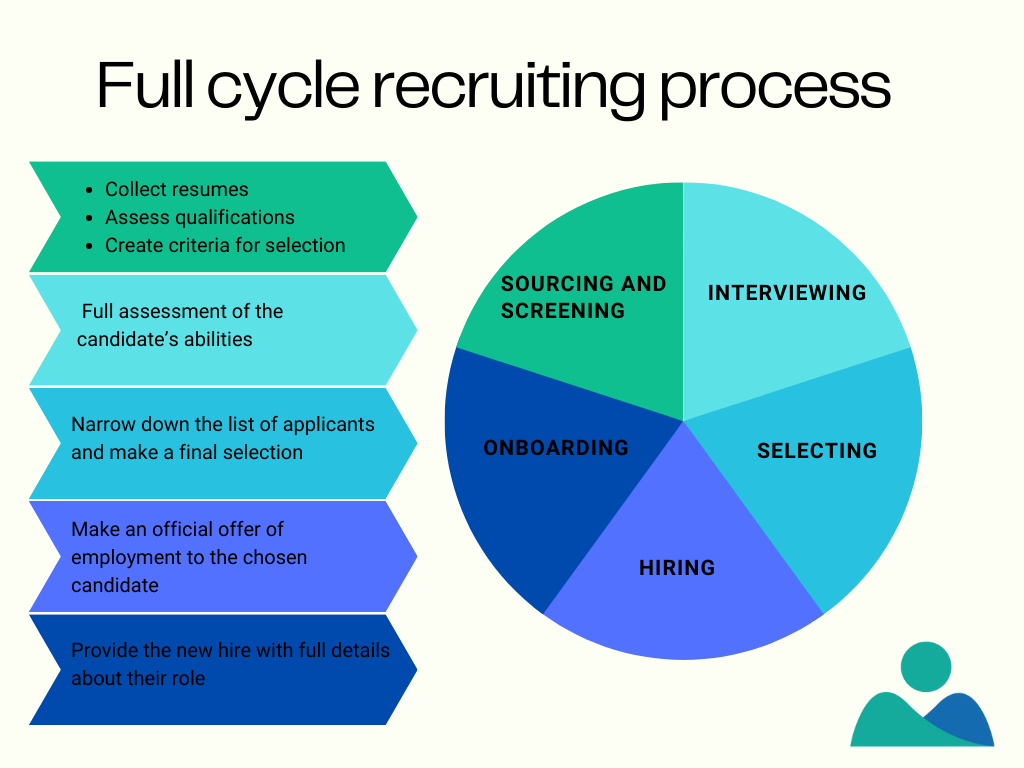The term “full cycle recruiting” gets thrown around a lot in the human resources world. However, not everyone understands what it entails. Full-cycle recruiting is the process of sourcing, screening, and onboarding new employees.
In this blog post, we will define full-cycle recruiting, outline the benefits of utilizing this method, and discuss the five stages involved. By understanding full-cycle recruiting, you can streamline your hiring process and make sure you are getting the best talent for your company.
In this Article:
What is full cycle recruiting?
Full cycle recruiting is the process of finding and hiring the best candidate for a role through the use of various recruiting methods. Usually, in big companies, there is an HR department where each member of the team specializes in a different stage of recruiting. Even so, one person always oversees the entire process.
Full cycle recruiting includes sourcing passive candidates through job boards, job description postings, and passive candidate outreach; screening applicants based on qualifications, skills, and experience; selecting qualified candidates for phone or in-person interviews; and onboarding new hires into the organization.
What are the 5 stages of the recruitment process?
The full cycle recruiting process starts at zero and ends the job once the right person is recruited. The primary difference between complete cycles and other types is that complete cycles provide all the components of recruitment. The full cycle recruiting process includes the following five stages.

Sourcing and Screening
The first part of full cycle recruiting is to source potential candidates. This step involves collecting resumes, assessing qualifications, and creating criteria for selection. During this phase, recruiters should also screen the applicants for job-specific skills and experience.
Interviewing
Once a pool of potential candidates has been identified, recruiters should conduct in-depth interviews to further assess the applicant’s qualifications. Interviewing candidates can help recruiters to make a full assessment of the candidate’s abilities and decide if they would be suitable for the role. The goal is to determine whether the candidate is a good fit for the position and organization.
Selecting
After interviewing each candidate, recruiters can narrow down their list of applicants and make a final selection. This step allows recruiters to evaluate the overall qualities of each candidate at once and make an informed decision about which one is most suitable for the role. It is important to select a candidate who will be the best fit for the position and company.
Hiring
This step involves making an official offer of employment to the chosen candidate, as well as all the necessary paperwork and background checks. After making the job offer, recruiters should provide full details about the position and ensure that all necessary information is communicated to the new hire.
Onboarding
The recruiting cycle is not complete until the new hire has been properly onboarded. This step involves providing the new hire with full details about their job duties, company policies, and any other relevant information. Onboarding also helps to make sure that the new hire is settled in and smoothly integrated into their role.
What are the benefits of full cycle recruiting process?
Full cycle recruiting can be beneficial for candidates, recruiters and organizations. It offers a full picture of the application process, from start to finish. Candidates benefit from end-to-end recruiting because the full cycle recruiter can provide a holistic view of their career path.
Better Quality of Hire
A well-executed full cycle recruiting process allows you to thoroughly evaluate candidates based on their skills, qualifications, and cultural fit. By implementing comprehensive screening techniques, including behavioral assessments, technical evaluations, and reference checks, you can ensure that you are selecting the most suitable candidates for your organization. This leads to higher-quality hires who are more likely to contribute to your company’s success and longevity.
Better candidate experience
Full cycle recruiters offer a full view of the hiring process to potential candidates. This lets them get to know their background, skills, and experience throughout the entire process. By creating transparency in the full cycle recruiting process, recruiters provide an excellent candidate experience. Candidates also benefit from full cycle recruiter’s expertise as they can gain insights on the full range of job options available. This helps ensure that any potential job offer is an ideal fit for both parties.
Time and Cost Efficiency
By implementing a full cycle recruiting process, you can streamline and optimize your hiring procedures, resulting in significant time and cost savings. With a structured approach in place, you can eliminate inefficiencies, reduce time-to-fill positions, and decrease the need for extensive candidate sourcing. Moreover, a comprehensive process helps to minimize turnover rates by ensuring better candidate selection and reducing the expenses associated with repeated recruitment efforts.
Proactive Succession Planning
The full cycle recruiting process not only focuses on filling immediate vacancies but also takes into account long-term organizational needs. By actively identifying potential future leaders and key positions within the company, you can develop a succession plan that ensures a smooth transition and minimizes disruptions. This strategic approach allows you to nurture and groom internal talent, reducing the reliance on external hiring and promoting a culture of growth and advancement within your organization.
Continuous Improvement and Data-Driven Decisions
The full cycle recruiting process allows for continuous improvement through the analysis of data and metrics. By tracking and evaluating key recruitment metrics, such as time-to-fill, cost-per-hire, and candidate satisfaction, you can identify areas for optimization and make data-driven decisions. This iterative approach ensures that your recruitment efforts are continuously refined. Eventually, you will obtain better outcomes and increased success rates in hiring the right candidates.
Long-Term Employee Engagement
The full cycle recruiting process goes beyond the initial hiring phase and extends into the onboarding and integration of new employees. By providing a well-structured onboarding program that familiarizes new hires with the company culture, policies, and procedures, you can enhance their overall engagement and job satisfaction. A comprehensive onboarding process sets the stage for a positive employee experience, increases retention rates, and promotes long-term commitment to the organization.
Tips for Learning Full Cycle Recruiting

- Stay updated: The recruitment landscape is constantly evolving. Therefore, it’s essential to stay updated on the latest trends, technologies, and best practices in the industry. Attend conferences, webinars, and workshops, and engage in continuous learning to enhance your recruiting skills.
- Build relationships: Networking plays a significant role in recruiting. Build relationships with professionals in your industry, attend networking events, and join relevant online communities. These connections can provide valuable insights, referrals, and potential candidates for future positions.
- Develop your sourcing strategies: Experiment with different sourcing strategies to attract a diverse pool of candidates. Explore social media platforms, professional networks, and industry-specific forums to expand your reach. Don’t limit yourself to traditional job boards; explore niche platforms to tap into specialized talent pools.
- Enhance your screening techniques: Refine your screening and assessment methods to identify the most qualified candidates efficiently. Consider utilizing applicant tracking systems (ATS) and AI-powered tools that can streamline the screening process, saving you time and effort.
- Develop interviewing skills: Conducting effective interviews is crucial in assessing a candidate’s suitability for a role. Practice active listening, ask insightful questions, and create a comfortable environment for candidates to express themselves authentically. Use behavioral-based interview techniques to gauge their past experiences and problem-solving abilities.
- Seek feedback and learn from experience: Continuous improvement is vital in mastering full cycle recruiting. Seek feedback from hiring managers, candidates, and colleagues to identify areas where you can enhance your skills. Reflect on your recruitment experiences and learn from both successes and challenges.
A word from SublimePeople
This process has been shown to provide tangible benefits to businesses of all sizes. From increasing efficiency and saving time and money to improving employee retention rates and reducing staff turnover costs, there are many reasons why every business should consider implementing a full-cycle recruiting process.
SublimePeople can help you find the right candidates for your organization. With our unique recruitment process, we identify, select, and send through the talent you are really looking for. Contact us today and take your business to the next level!


